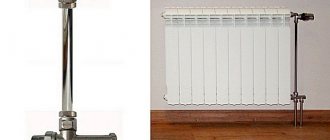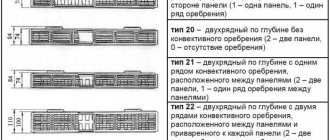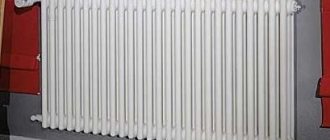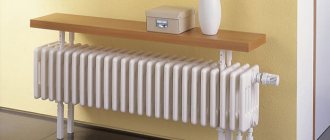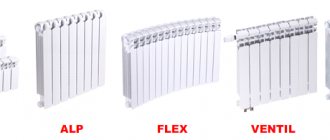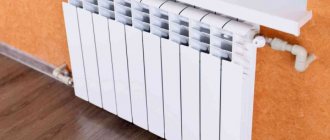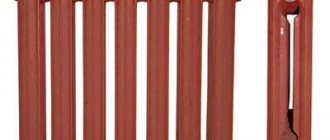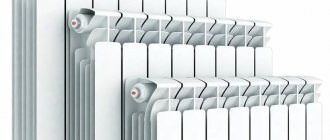The influence of the placement and method of connecting radiators on heat transfer
The best location for the radiator is under the light openings, since the greatest heat loss occurs through the window, no matter how insulated it is. In addition, hot air from the heating device creates a thermal curtain: cold air from the window does not spread throughout the room, circulation improves.
Changes in the thermal power of the radiator depending on the placement and presence of a screen.
If you decide to hide radiators under screens or decorative panels, this will lead to a loss of power. Sometimes such measures are resorted to in order to purposefully reduce the strength of the heat flow by 10-15%.
Reduced thermal power with different connection methods.
The method of connecting radiators also has a significant impact:
- Bilateral or unilateral. Connecting pipes from different sides helps to increase the heat transfer of the battery; with this connection, the power of the device corresponds to the declared maximum. However, for radiators with less than 20 sections, it is better to install pipes from one side.
- Top or bottom. The supply of coolant to the upper part of the battery, when removed through the lower part, has a minimal effect on heat transfer. Feeding from bottom to top reduces the indicator by 20-22%.
How to calculate the power of a panel radiator
P (radiator) = V * 41
- P – radiator power
- V – room volume (height * length * width)
- 41 is 41 W of thermal power required to heat 1 cubic meter of standard construction
For example: a room 6 * 7 meters, with a ceiling height of 3.5 meters. First, we calculate the volume of the room V = 6 * 7 * 3.5 = 147. We use the calculation formula: P (radiator) = 147 * 41 = 6027 W.
We received a figure that means how much heat needs to be given to the battery to warm up a given room. That is, in this case it is necessary to use two 2500 W radiators and one 1000 W radiator. Calculating the number of sections is very simple; just divide the resulting power by the power of one section.
Heating radiator sizes
The standard height of the most popular models of heating devices with the center distance along the connections is 500 millimeters. These are the batteries that in most cases could be seen about two decades ago in city apartments.
Cast iron radiators
. A typical representative of these devices is model MS-140-500-0.9.
The specifications for it include the following overall dimensions of cast iron heating radiators:
- the length of one section is 93 millimeters;
- depth - 140 millimeters;
- height – 588 millimeters.
Calculating the dimensions of a radiator from several sections is not difficult. When the battery consists of 7-10 sections, add 1 centimeter, taking into account the thickness of the paronite gaskets. If the heating battery is to be installed in a niche, it is necessary to take into account the length of the flushing tap, since cast iron radiators with side connections always require flushing. One section provides a heat flow of 160 watts at a temperature difference between the hot coolant and the air in the room of 70 degrees. The maximum working pressure is 9 atmospheres.
Aluminum radiators
. For aluminum heating devices on the market today, with the same center-to-center spacing of the connections, there is a significant variation in the parameters (for more details: “Dimensions of aluminum heating radiators, section volume, preliminary calculations”).
Typical sizes of aluminum heating radiators are:
- the length of one section is 80 millimeters;
- depth 80-100 millimeters;
- height - 575-585 millimeters.
The heat transfer of one section directly depends on the area of its fins and depth. Typically it ranges from 180 to 200 watts. The operating pressure for most models of aluminum batteries is 16 atmospheres. Heating devices are tested with one and a half times higher pressure - this is 24 kgf/cm².
Aluminum radiators have the following feature: the volume of coolant in them is 3 and sometimes 5 times less than in cast iron products. As a result, the high speed of movement of hot water prevents silting and the formation of deposits. Bimetallic radiators
. The steel core in such devices does not in any way affect their appearance and the size of the heating radiators, but the maximum operating pressure increases significantly. Unfortunately, the increased strength of the bimetallic battery leads to high costs. And the price of such a product is already inaccessible to a wide range of consumers.
Bimetallic heating radiators have the following section dimensions:
- length 80-82 millimeters;
- depth - from 75 to 100 millimeters;
- height – minimum 550 and maximum 580 millimeters.
In terms of heat transfer, one bimetallic section is inferior to an aluminum section by about 10-20 watts. The average heat flux is 160-200 watts. Due to the presence of steel, the operating pressure reaches 25-35 atmospheres, and during testing - 30-50 atmospheres.
When arranging a heating structure, you should use pipes that are not inferior in strength to radiators. Otherwise, using durable devices loses all meaning. For bimetallic radiators, only steel liner is used.
Main dimensions
Dimensions mean:
The center-to-center distance (also called inter-nipple or center-to-center) should not be confused with the height of the heating radiator. The first indicator indicates how many centimeters are between the upper and lower collectors (holes). Height is the distance between the lowest and highest point of the section.
Aluminum heating radiators have the following dimensions:
- The center distance ranges from 150 to 2,000 mm. Very tall radiators are rare. The most popular are radiators with an inter-nipple distance of 500 mm. This is because the current heating network pipe system was created for cast iron batteries, which have the same center-to-center distance. Since many owners did not and do not have the desire to digest pipes, they simply selected/are selecting a suitable radiator and, thereby, increased the popularity of a battery with an interaxial distance of 0.5 cm. This indicator is very important, and therefore manufacturers indicate it in the name of the battery (RAP-500, Rococo 790, Magica 400, etc.).
- The height is in the range of 245-2000 mm. According to this criterion, batteries can be divided into low, medium and high. The features of each type will be discussed below.
- The section depth ranges from 52 to 180 mm. Some models may have greater depth, however, this is rare.
- The section width is 40-80 mm.
Types of radiator connections
If connecting the bottom method of connecting the radiator. it will be equipped with a special valve for temperature control, which will immediately provide the required temperature.
When connecting a steel radiator to the side, a standard scheme for circulating heat in the room is used, and such a connection is cheap and not at all remarkable or noticeable.
Fabrication with multiple panels will result in greater heat input. Various metal alloys can also be mounted to them, as a result the size of the base, which provides heat transfer, will increase.
Types of battery connections
However, these heating systems also have distinctive features, for example, weight. According to this criterion, they can reach the weight level of cast iron installations, which are quite heavy. Also, the volume of water will be a minus, which means that thermal regulation will be lower and, accordingly, heat transfer too. The thickness of the radiator can reach 160 mm, which exceeds the thickness of cast iron. In addition, the inner shell of such batteries is difficult to clean.
Products made from pipes help us remember the times of cast iron batteries. they are similar in external parameters. In most cases, the installation of cast iron batteries is carried out in administrative buildings and residential buildings of the Stalin period. They are resistant to strong atmospheric pressure up to 10, can reach more than one hundred cm in length, and a maximum width of 2 cm. They can also be sectional or non-sectional.
Design Features
Water contains a large number of impurities. When in contact with aluminum, they cause corrosion. Over several years of use, these processes will lead to leakage of the device.
The design feature of these radiators is the presence of an internal stainless steel core, which is surrounded on the outside by an aluminum alloy. This way, water does not come into contact with aluminum, which significantly extends the service life of the system.
There are two manufacturing options:
- Pseudobimetal. In this case, the steel core is located only inside the vertical channels. So aluminum is not completely protected, but only in the weakest places. These models are cheaper and have a standard service life of up to 10 years if used in systems with high water pressure (for example, in city apartments).
- Bimetal. It has a solid inner casing made of steel, which is filled with aluminum alloy under pressure. Here the aluminum is protected on all sides. These are more expensive models and their service life under similar operating conditions is up to 30 years.
Design of a bimetallic batteryThe manufacturing method directly affects the volume of water in the section of the bimetallic radiator.
If we compare it with any other battery, the volume of one section here will be significantly lower. The disadvantage is compensated by the presence of two alloys. As a result, the inner steel core prevents the aluminum shell from cooling quickly. There are different ways to join two metals. It is preferable if aluminum is poured over steel under pressure. This battery model will last longer. There is an option when metals are joined together by welding.
According to the technical type of design, radiators can be:
- Collapsible. This means that using a radiator wrench you can unscrew any number of sections and screw them to another radiator. This type is most often installed in private houses with an autonomous heating system, where there is no high water pressure.
- Non-separable. The radiator is monolithic, it cannot be untwisted, cut, or attached to another. Perfect for use in a city apartment, where there is always a high level of pressure.
Aluminum radiators: dimensions
When installing modern individual water heating systems, aluminum batteries are most popular. Some technical characteristics of aluminum radiators make them not entirely suitable in conditions of centralized coolant supply, where large pressure and temperature differences are typical. Also, sometimes the quality of the circulating fluid leaves much to be desired. But for autonomous heating circuits, such products are ideally suited for most parameters (both technical and aesthetic).
However, not all batteries are created equal. They are distinguished by such parameters as:
- dimensions;
- power (heat dissipation);
- preparation method;
- capacity (how much water is included in one section);
- weight.
It is clear that, in addition, the products have different manufacturers, although, taken as a whole, the main characteristics depend slightly on the brand. Each of the properties listed above will be described in more detail later in the article. This information may be useful if you need to select a battery for installation in a new heating system or replace another device or a separate section.
Dimensions of aluminum radiators
When it comes to the size of batteries, we rather mean the linear characteristics of one section, which determine the dimensions of the assembled structure. The dimensions of the section are determined:
- center distance;
- depth;
- width.
The first linear indicator, which essentially determines the height of the prefabricated product, is the most important. The total area of the device directly depends on it, which, in turn, affects the heat transfer of aluminum radiators, that is, the operational efficiency of the heating device. Also, the center-to-center distance determines the possible installation location of heating radiators in an apartment or house, as well as the method of connecting pipes to it.
The standard distance between the center of the upper and lower openings of a section is 50 and 35 cm. These are the most common sizes, accounting for about 80% of all products. The rest of the aluminum sections can have center distances from 20 to 80 cm.
Recently, radiators of non-standard shapes have appeared. These are so-called plinth-type devices. They are characterized by a small height, which is compensated by a significant length. In contrast to the previous type, there are vertical batteries, which, with a small width, can reach a height of 2-2.5 m.
The standard depth, that is, the anteroposterior size of the products is most often 8.5 cm, although often 10 cm. The width of the structural unit of the heating device is usually 8 cm.
The length of the battery depends on the number of sections that are included in it. For example, a device made of 10 structural elements will have a length of 80 cm.
Aluminum radiator power
This is perhaps the main characteristic that determines the efficiency of a device designed to heat a room. Based on heat transfer, the size of the battery required to heat each room of a certain volume is calculated. In the technical data sheet that accompanies each product when it is sold, the manufacturer indicates the power of one section of cast iron radiators. To determine their total quantity, you need to know how many kW of heat is needed to sufficiently heat a particular room.
The power of the aluminum radiator section is quite high due to the high thermal conductivity of this metal. Thus, the heat transfer declared by manufacturers for one structural element with an interaxial distance of 50 cm ranges from 0.185 to 0.210 kW. With a distance between the axles of 35 cm, the power indicator is in the range of 0.140-0.165 kW.
The heat requirement of a room with a ceiling height of 270–280 cm is determined at the rate of 1 kW per 10–12 m2 of area. That is, for a room of 20 m2 with a standard ceiling and average thermal insulation of surfaces, you need about 2 kW of heat per hour for full heating.
This means that for this room you will need to install one or more radiators (depending on the number of windows), consisting of a total of 11 sections with a distance between the axes of 50 cm. If you plan to install radiators with an interaxial length of 35 cm, the total number of structural elements should be increased to 14-15 pieces.
Preparation method
To be precise, it should be noted that for the manufacture of heating devices, not pure aluminum is used, but its alloy with silicon (silumin). The silicon content, which ranges from 13-15%, provides the material with additional strength, that is, the ability to withstand higher pressure. But even this alloy is inferior in strength to other metals that are used in the production of heating radiators. That is why such products are not recommended for installation in circuits powered by a centralized coolant supply, where, in addition to normal high pressure, so-called water hammers are possible.
According to manufacturing technology, silumin products are:
- cast;
- extrusion.
In the first case, casting technology is used, when the section is cast completely with fins and front panels. In this option, each structural element is manufactured separately, that is, it is possible to assemble a heating battery with an arbitrary number of forming units. This production method is considered to be of higher quality, which is why the cost of such products is slightly higher.
Radiators produced by extrusion have a lower price. The inconvenience is that the sections are sold in blocks of several pieces, which does not make it possible to accurately select the power of the heating device. Another peculiarity is that the design is not continuous. Some elements are mounted additionally.
However, the main technical properties, such as power, internal water volume or weight, are not particularly affected by the production method.
Internal volume of radiators
A parameter such as the capacity of heating devices affects the total volume of water circulating in the heating circuit. And this indicator needs to be known when calculating:
- circulation pump power;
- boiler power;
- volume of antifreeze (if this type of coolant is used and not water).
On average, the volume of water in one structural unit of aluminum heating devices ranges from 350-400 ml. For comparison, the same figure for cast iron products is about 1200 ml. That is, the volume of water in the aluminum section is three times less. Therefore, when using antifreeze as a coolant, aluminum products allow you to save sometimes quite expensive liquid.
Also, a small volume of water or other coolant allows you not to overload the circulation pump and install it at a lower power, which allows you to significantly save energy.
How much does an aluminum radiator weigh?
Many people know that aluminum is one of the lightest metals used in industry and everyday life, due to which aluminum products are lightweight. The aluminum-silicon alloy used to make heating radiators is only slightly heavier than the pure material. Therefore, the weight of radiators is very small when compared with analogues of the same size made from other materials.
For example, what is the weight of 1 section of a cast iron battery? The weight of the aluminum structural unit does not exceed 1.3 kg. The weight of the cast iron section depends on the size and its weight ranges from 3.5 to 5.5 kg. Therefore, to install such heating devices, there is no need to use too strong fasteners when the weight of a battery consisting of 10 units does not exceed 14 kg.
As you can see, the linear dimensions, weight and internal volume of water of aluminum batteries are much smaller than analogues made of other materials. Therefore, the demand for precisely such heating devices is understandable, given that their thermal power is much higher.
Possible problems during operation
Bimetal devices have a large number of advantages. Which of their features can be considered disadvantages?
- Despite the possibility of using bimetallic batteries in a system with any coolant, the low quality of the latter negatively affects the service life of the device.
- Different coefficients of expansion of the metals present in the battery design can, over time, lead to instability of heat transfer and a decrease in the strength of the device.
- The use of low-quality coolant in the system can lead to clogging of channels, corrosion, and deterioration of heat transfer.
Low batteries
Radiators with a small center distance have the following advantages:
- they can be placed under a low window sill;
- they have maximum heat transfer per unit area.
Cast iron radiators
.
The dimensions of the MS-140M-300-0.9 heating radiator sections are:
- length 93 millimeters;
- depth - 140 millimeters;
- height – 388 millimeters.
Due to their smaller dimensions, the heat transfer of cast iron heating radiators is reduced - it is equal to 106 watts from one section at an operating pressure of 9 kgf/cm². Among foreign analogues, there are cast iron products with an interaxal distance along the connections equal to 200 and 350 millimeters; the power of a section of a cast iron radiator of this type is much higher.
Aluminum radiators
. For low batteries made of aluminum, both domestic and imported, the spread of the center distances is quite large. You can find radiator sizes of 150, 300 and even 450 millimeters. Since the possible section length starts from 40 millimeters, the device looks compact and unusual. Low aluminum heating radiators have height dimensions starting from 200 millimeters. The depth of many models compensates for the lack of the other two parameters and is 180 millimeters.
As for thermal power, it varies from a minimum of 50 watts per section to a maximum of 160 watts. The determining factor is the fin area of one section. At the same time, the change in dimensions does not significantly affect the operating pressure - low aluminum devices are designed for 16 atmospheres, and when testing - 24 atmospheres. Bimetallic radiators
. All the sizes of heating radiators that they have are also typical for aluminum heating devices. Thermal power is within the same limits. On sale you can find aluminum low radiators with heat output of 80 and 140 watts per section. The working pressure is 25-35 atmospheres.
Bimetallic low radiators, such as in the photo, have two nuances:
- among heating devices there are batteries not with solid steel cores, but with steel tubes placed between aluminum collectors. Their operating pressure, indicated by manufacturers, is usually 12 or 16 atmospheres;
- they often do not have vertically located channels and, in the case of a lateral connection, can be heated by the collectors due to the thermal conductivity of aluminum. The circulation of the coolant is ensured by the last section, since it is flow-through.
Parameters and dimensions of aluminum radiators ROVALL
The company producing aluminum radiators TM ROVALL is one of the divisions of the Italian concern Sira Group. This company produces batteries from aluminum alloy with a distance between the two collectors of 200, 350 and 500 millimeters. The kit for their fastening, which is purchased separately, includes the following products: plugs, adapters, for connecting sections - nipples with gaskets and for wall mounting - brackets, as well as a Mayevsky tap. Main parameters of ROVALL aluminum radiators:
- permissible operating pressure is 20 bar, and when tested - 37.5 bar;
- maximum temperature – no more than 110 °C.
All Rovall devices of the Alux 200 models, according to official sources of the manufacturer, have a distance of 200 millimeters between the axes, a height of 245, and a depth of 100 millimeters. In this case, the minimum length is 80, and the maximum is 1280 millimeters. In turn, heat transfer can be a minimum of 92, and a maximum of 1472 watts. The number of sections varies from one to 16.
The Rovall Alux 350 radiator models, with a distance of 350 millimeters between the collectors, have a height of 395 and a depth of 100 millimeters. In this case, the minimum length of the devices is 80, and the maximum is 1280 millimeters. In turn, heat transfer can be from 138 to 2208 watts. The number of sections is from one to 16.
Models of Rovall Alux 500 devices, with an interaxial distance of 500 millimeters, have a height of 545 millimeters and a depth of 100 millimeters. At the same time, the minimum length of the devices is 80, and the maximum is 1280 millimeters. In turn, the power can be a minimum of 179, and a maximum of 2840 watts. The number of sections ranges from one to 16.
Difference between cast iron and bimetallic batteries
Radiators, consisting of two types of metals at once, came to the domestic market from Italy and quickly won the hearts of consumers, despite their high cost. This can be explained in one word: “reliability”. If you choose which is better, cast iron or bimetallic batteries, then you should compare their technical indicators:
- Structure:
- Cast iron structures now look stylish, but they are also assembled from sections equipped with a fairly wide channel for the coolant. Their weight has become significantly less (3.5 kg versus 8 kg previously), their appearance is more presentable, and their reliability is the same. The market offers classic sectionals and artistic, retro style ones. The latter are very expensive, and mostly imported.
- Bimetallic structures consist of a steel or copper core with aluminum fins and housing. The coolant comes into contact exclusively with stainless steel, which protects the device from corrosion, and the casing ensures high heat transfer. Such a heater weighs little, is easy to install, and additional thermostats allow you to monitor the heating of the coolant.
- Heat dissipation level:
- If you decide whether cast iron or bimetallic radiators heat better, then their performance will be approximately equal. So the heat transfer of a cast iron section ranges from 100 W to 160 W. Many consumers feel that they take too long to warm up, and they are right. At the same time, everyone forgets that these batteries also take a very long time to cool down.
- The heat transfer of one section of a bimetallic radiator is 150-200 W, which, with instant heating, brings this type of heaters to a leading position.
- Operating pressure:
- Although many years of experience in using cast iron batteries suggests that they are strong and reliable, this is not entirely true when it comes to high-rise buildings. Even in five-story buildings, quite strong water hammers can occur in the heating system, let alone buildings of 16 floors and above. The operating pressure of cast iron batteries is 9-12 atmospheres, which may not be enough if the pressure rises sharply, for example, up to 15 atmospheres. In this case, the cast iron sections will simply burst.
- Bimetallic radiators are more reliable, since their operating pressure is 25-40 atmospheres, and in some models even 100 atmospheres. At this point, designs made of two types of metal also lead.
- Coolant resistance:
- Cast iron is absolutely “indifferent” to the quality of water and its acidity. Completely draining it in the summer does not affect it, but the pebbles that sweep through the system gradually weaken the cast iron, drain it and render it inoperable. This process is lengthy, and if the radiator walls are thick enough, it is completely endless.
- A bimetallic radiator is weaker in this regard. It is not afraid of the acidity level of the water as long as it is in the system, but as soon as it is drained, corrosion begins to appear after 2-3 weeks of contact with air. In this indicator, bimetal loses to cast iron.
- In terms of temperature, both types of radiators tolerate temperature changes well. For cast iron, the maximum water heating is +110, and for bimetal - +130 degrees.
- Today you can find cast iron batteries whose age has exceeded 100 years, but on average they have a service life of 50 years. Manufacturers set a limit of 25-30 years for bimetallic radiators, which is less than that of cast iron.
Bimetallic heaters are the best option for replacing old batteries. In key respects, they are superior to cast iron devices, which guarantees their effective operation in the unfriendly environment of centralized heating. In addition, they are much easier to install, they are lightweight and do not require additional maintenance.
If the question is whether to replace cast-iron radiators with bimetallic ones or not, then residents of five-story buildings do not have to do this, especially since the latter devices are twice as expensive. Residents of high-rise buildings will have to abandon cast iron batteries, since they will not withstand the load of the system and will leak. In this option, there is definitely nothing better than bimetallic structures.
Classification of heating radiators by material of manufacture
Depending on the material of manufacture, there are the following types of radiators: cast iron, aluminum, steel and bimetallic. Copper heating radiators are practically not used today due to their high cost.
Cast iron
Cast iron units are commonly used in older homes. They cannot boast of external attractiveness and compact size.
Their main advantages:
- Corrosion resistance and impressive service life (up to 50 years).
- Possibility of use in systems with high pressure and not very clean coolant.
- After heating stops, they retain heat for a long time.
- Can be combined with pipes made of other materials.
- High heat transfer due to the vertical arrangement of the fins.
- Strength and thermal resistance.
- Low hydraulic resistance inside and protection against blockages.
Among the disadvantages are the impressive weight and rather large dimensions, as well as prolonged heating of the room. A thermostat cannot be built into such devices. The surface needs care and painting.
Technical characteristics of cast iron models:
- thermal power – 110-150 W;
- weight of one section – 8-9 kg;
- working pressure – 9-18 atm.;
- unit height – 37-57 cm;
- width – 60-90 cm;
- coolant temperature – up to 150°C.
Aluminum
Aluminum inverter heating batteries operate on the principle of convection. They radiate heat into the room, which they receive from the heated coolant liquid.
Such units have the following technical characteristics:
- working pressure is in the range of 6-16 atm.;
- maximum coolant temperature – 110°C;
- section thermal power – from 80 to 215 W;
- service life – up to 20 years;
- axial distance – 35-50 cm;
- device height – 38-59 cm;
- width – 80 cm.
There are two types of aluminum radiators - extruded and cast. The last type is a structure cast from molten metal under high pressure. The profile of extrusion batteries is obtained through a pressing process and then divided into individual parts. Then the sections are connected and sealed.
Advantages of aluminum units:
- Light weight and good heat dissipation, as well as an affordable price compared to devices made of copper or cast iron.
- Valves can be installed to regulate the temperature.
- Durability and attractiveness.
Flaws:
- due to the use of sealing gaskets, they are not suitable for systems with antifreeze;
- low corrosion resistance, therefore suitable only for water with low acidity;
- metal oxidation leads to airing of the system;
- weak areas at threaded connections;
- low resistance to water hammer.
Bimetallic
The design of these units has an aluminum body, inside of which there are steel pipes. Some devices have steel pipes inside only in the place where they are needed to strengthen the vertical channels. Such devices are cheaper, heat up faster, but are less durable than models with an all-steel core. They are tubular, panel and sectional.
Specifications:
- Working pressure – 18-40 atm.
- The coolant temperature is 110-130°C.
- Thermal power – from 125 to 180 W.
- Service life – up to 20 years.
The positive aspects of bimetallic batteries:
- do not require maintenance and give off heat well;
- resistant to mechanical stress and water hammer;
- thanks to a special coating inside steel pipes, they are not subject to corrosion;
- easy to install and lightweight;
- visually attractive.
Their disadvantage is their high cost. In addition, the steel core is susceptible to corrosion when exposed to a mixture of water and air.
Steel
These batteries boast a heat output of 1200-1800 W. They are capable of operating at pressures in the region of 6-15 atm. with coolant heated to 120°C. The thickness of the steel walls is 1.15-1.25 mm.
Advantages:
- They heat up quickly and transfer heat well to the room.
- They weigh little, are easy to install and are inexpensive.
- Visual appeal and the ability to combine with pipes made of different materials.
- Easy care thanks to its simple design.
- Temperature regulators can be installed.
The downside is the short service life (up to 10 years). Not suitable for central heating because without water they are susceptible to corrosion. They do not withstand water hammer.
Steel panel radiators
These are devices that combine the functions of a radiator and a convector. They are available in the form of rectangular panels of various sizes.
Radiators of this type have the simplest possible design. The basis is made of profiled steel panels, which are connected by welding. Inside the panel there are several vertical oblong channels through which the coolant circulates. The coolant heats the entire surface of the panel.
To ensure more efficient heat transfer, the structure is equipped with U-shaped ribs made of cold-rolled thin steel. They are installed to the panel from the back. This part of the structure provides convection heating of the room.
Each manufacturer produces a wide range of products of various types and sizes. Today on the market there are models of the following sizes:
- length - from 300 to 900 mm;
- width from 400 to 3000 mm;
- The depth of the device depends on how many panels are used.
Note! One of the main disadvantages of steel panel radiators is their increased tendency to become dirty. Therefore, along with the purchase of the radiator itself, it is recommended to take dirt filters.
Steel panel radiator under the window.
There are devices with different connection options: bottom, side and universal. Each of these connection types has its own advantages. The main advantage of the bottom connection is that the entire radiator piping is hidden at the bottom and is practically invisible, which does not spoil the interior of the room (unlike the side connection, in which taps and pipes are visible).
Depending on the model, panel-type steel radiators may have different characteristics:
- The maximum coolant temperature is 110-120°C.
- Working pressure: with a wall thickness of 1.2 mm - up to 9 atmospheres (pressure test up to 13.5 atm); with a thickness of 1.4 mm - up to 10 atm (pressure testing up to 15 atm). The devices are guaranteed to be destroyed at a pressure of 25 atm (according to factory tests by JSC NITI Progress, which produces Prado brand radiators). Due to the inability to withstand higher pressure, it is not recommended to use devices of this group in multi-storey buildings with central heating, where there are powerful water hammers.
Depending on the configuration, steel panel heating radiators are divided into several types:
Type 10.
Type 10 - single-row device without convector fins
Type 11.
Type 11 - single-row device with convector fins
Type 20.
Type 20 is a two-row device with a grille for warm air outlet, but without convector fins.
Type 21.
Type 21 (also called type 12) is a two-row device with one panel of convector fins and a grille for the release of warm air.
Type 22.
Type 22 is a two-row device with two panels of convector fins and a grille for the outlet of warm air.
Type 30.
Type 30 is a three-row device with a grille for warm air outlet, but without convector fins.
Type 33.
Type 33 is a three-row device with three panels of convector fins and a grille for the exit of warm air.
Advantages of steel panel radiators
- Long service life (more than 25 years).
- Possibility of functioning with any boilers.
- There are no such strict restrictions on the coolant that aluminum radiators have. The pH level should be in the range of 8.5 - 9.5, hardness up to 7, oxygen no more than 0.02 mg/kg of water, iron no more than 0.5 mg/l, however, the coolant should not contain aggressive components.
- Modern panel steel radiators have an attractive appearance; they can not only warm a room, but also become a real decoration for it.
- If you wish, you can do the installation yourself; there is nothing complicated about it; everything necessary for installation (dowels, screws, fasteners) is included in the package. In addition, almost every manufacturer offers instructions describing each installation step.
Flaws
- High sensitivity of panel models to water hammer at welds. The radiator may burst or become deformed during pressure testing.
Important! The inability to “hold” water hammer makes it impossible to install steel panel radiators in apartment buildings. They are mainly installed in private homes and country houses.
. Increased susceptibility to corrosion. Often the paintwork is not stable and if the battery is not made well, it begins to peel off after just a few years of use.
- Increased susceptibility to corrosion.
- Often the paintwork is not stable and if the battery is not made well, it begins to peel off after just a few years of use.
We recommend: Which pipes are best used for heating a private house: which pipes to choose for heating a private house, choice of pipes, what types there are
How to calculate the size of radiators for a room
Knowing the basic characteristics of heating equipment and the area of the room, you can easily determine the required radiator power, and subsequently all the characteristics of the system, including the boiler.
Let's look at a similar calculation using a real example:
Let’s say a room with the characteristics of 4x3x2.7 is planned for installation of heating - a standard bedroom in a Soviet Khrushchev-era building.
First, let's calculate the volume of the room that will have to be heated: 4*3*2.7=32.4 m3. It is this volume of air that our radiator will have to heat.
Then you should determine how much heat will need to be spent to heat this volume. Without taking into account measures to increase energy efficiency (energy saving, wall insulation, etc.), the standard for the temperate climate zone of Eastern Europe is the cost of heating one cubic meter of 41 watts.
Accordingly, to heat our room you will need: 32.4 m3 * 31 Watt = 1.3 kV
This is the amount of energy that the air needs to receive from the radiator for heating. Next, knowing the required amount of heat, you can calculate the technical characteristics of the radiator that will be mounted.
Each radiator has a heat transfer characteristic. This is the amount of energy that the equipment is capable of releasing into the atmosphere while maintaining the quality indicators of the heating system. This figure may be underestimated, but cannot be exceeded. The radiator power is always indicated on the packaging, in the passport or certificate.
Heating our room will require 1.3 kW of energy. To prevent force majeure effects during abnormal frosts, the indicator is calculated with a margin of 15-20%. In total we have 1.5 watts.
One fin of a standard bimetallic radiator is capable of delivering up to 150-180 Watts of energy. Total: 1500/150=10. Those. To fully heat our room, we will need to install a 1.5 kW radiator, consisting of 10 fins.
If the walls are insulated and vacuum metal-plastic windows are installed, the actual energy consumption for heating can be reduced by 2 or more times. Accordingly, there is no point in purchasing a radiator of higher power.
Calculation by area
This is the simplest option for determining a more or less exact amount of heat required for heating. When calculating, the main starting point is the area of the apartment or house where heating is organized.
The area of each room is available in the apartment plan, and to calculate specific values for heat consumption, SNiP comes to the rescue:
- For the average climate zone, the norm for a residential premises is defined as 70-100 W/1 m2.
- If the temperature in the region drops below -60 degrees, the heating level of each 1 m2 must be increased to 150-220 W.
To calculate panel heating radiators by area, in addition to the given standards, you can use a calculator. The power of each heating device must be taken into account. It is better not to allow significant overexpenditures, because... As the resulting power increases, the number of batteries in the system also increases. In the case of central heating, such situations are not critical: there, each family pays only a fixed cost.
It’s a completely different matter in autonomous heating systems, where the consequence of any overconsumption is an increase in payment for the volume of coolant and the operation of the circuit. It is impractical to spend extra money, because... Over the course of a full heating season, a decent amount can accrue. By using a calculator to determine exactly how much heat is needed for each room, it is easy to find out how many sections to purchase.
For simplicity, each heating device indicates the amount of heat it produces. These parameters are usually contained in the accompanying documentation. The arithmetic here is simple: after determining the amount of heat, the resulting figure must be divided by the battery power. The result obtained after these simple operations is the number of sections required to replenish heat leaks in winter.
For clarity, it is better to look at a simple example: let’s say that you need only 1600 Watts, with the area of each section being 170 Watts. Further actions: the total value of 1600 is divided by 170. It turns out that you need to purchase 9.5 sections. Rounding can be done in any direction, at the discretion of the home owner. If there are additional heat sources in the room (for example, a stove), then you need to round down.
The opposite direction is calculated if the room has balconies or spacious windows. The same applies to corner rooms, or if the walls are poorly insulated. The calculation is very simple: the main thing is not to forget about the height of the ceilings, because... it is not always standard. The type of building material used to construct the building and the type of window blocks also matter. Therefore, the data for calculating the power of steel heating radiators should be taken as approximate. The calculator is much more convenient in this regard, because... it provides for adjustments to building materials and premises characteristics.
Features of bimetallic radiators
The second option that the store can offer you is a bimetallic radiator. The prefix “bi” in the word “bimetallic” means “two”. This name is given to this type of battery because they are made from two metals: steel and aluminum.
Let's immediately turn to the positive characteristics of this species:
- The steel in the material from which the body is made will perfectly withstand any surges in water pressure. It is also not subject to corrosion. These properties of the metal ensure high strength and many years of faithful service of the device;
- steel sheet provides serious protection of the case from external mechanical damage;
- active coolant circulation;
- Aluminum coating will ensure rapid heating of the air in the living room;
- battery operating pressure can reach 40 atm;
- the maximum possible coolant temperature is approximately 130 degrees, while for aluminum products it is only 110;
- durable paint coating on the body. This stability is achieved through a two-stage dyeing mechanism:
- First of all, the product is placed in a dye solution and completely covered with paint;
- Then another polymer layer based on epoxy resin is sprayed on top of the dried first paint. Radiators processed using this technology not only look very aesthetically pleasing, but also take on clearer geometric shapes;
easy installation and transportation, especially if you seek the help of professionals. The design of bimetallic batteries is no more complicated than that of simple aluminum ones, however, their installation is also best left to professionals. How long the batteries are installed correctly, the longer they will serve you; the ability to add additional sections directly to your home
However, if you assume that you still want to increase their number, when purchasing, pay attention to the design of the radiator housing. Some of the models on the market have a solid steel core, so they are not divided into sections.
Bimetallic radiator section
One of the options for the appearance of a bimetallic radiator
Let's pay attention to the disadvantages of bimetal devices:
- aluminum used in combination with steel loses its high heat-transfer properties. Due to the steel core inside the battery, you will have to wait a little longer than you are used to for the air to reach the desired temperature;
- increased price. Since the price of steel is higher than silicon, the cost of bimetallic batteries also increases by about 30% compared to aluminum ones;
- increased operating costs. Since bimetallic devices boast increased hydraulic resistance, the amount of energy spent on water circulation will also increase;
- Improper use of radiators can lead to corrosion of its steel parts. This will definitely happen if bimetallic batteries are installed in your dacha, which is not used in winter. As soon as the autumn heating season comes to an end, it will be necessary to carry out the procedure of draining the water from the system. It is because of this that corrosion processes will begin: simultaneous contact of steel with air and water instantly starts them.
- The small tube passage inside the device is subject to rapid clogging. This shortens the service life of the device.
Important! The coefficients of thermal expansion of steel and aluminum differ, which is why the battery begins to emit loud crackling sounds after a short period of time. This sound does not mean that there is a problem inside the device.
Don't worry, your health is safe!
These modern radiators can function properly even in rooms where the air humidity level is high. Their surface is resistant to corrosion. The radiator is given such resistance to aggressive environmental influences by sheet steel, which covers the body of the device with a protective layer.
Inside bimetallic radiators there are water channels of small cross-section. Due to their modest size, they are filled as quickly as possible with hot water coming from a centralized water supply system or an autonomous boiler.
Construction professionals consider purchasing bimetallic batteries and installing them during renovations as one of the best functional improvements to an apartment. Over time, the use of these devices will fully pay for the money spent on them.
Characteristics of electric radiators.
There is an alternative to central heating, it is an electric heating system. Such a system has a number of advantages: it heats well, is extremely easy to install, compact, and silent in operation. It is worth noting that an electric heating system is more economical than central heating and other heating systems, because... the cost of installing the system and the energy spent working is significantly lower. It is possible to regulate energy consumption depending on the time of day and outside temperature, which also contributes to savings.
Advantages of electric radiators:
Easy installation of the heating system; The system is environmentally friendly; Saves space because
electric heating radiators are very compact; The safety of using an electrical appliance is ensured thanks to the presence of special sensors; Fully autonomous operation with a standard supply voltage of 220 V; Thanks to their design, electric batteries will harmoniously fit into any interior; It is possible to select the number of electric battery sections, depending on the room parameters. Please note that it is necessary to decide on the choice of heating system at the building design stage. The main disadvantage of an electric convector is the cost of electricity
Electricity consumption directly depends on possible heat losses in the room - doors, type of double-glazed windows, window area, size and quality of room insulation
The main disadvantage of an electric convector is the cost of electricity. Electricity consumption directly depends on possible heat losses in the room - doors, type of double-glazed windows, window area, size and quality of room insulation.
Conclusion: If you are the owner of private houses and apartments that are equipped with autonomous heating systems, you can choose batteries based on your aesthetic preferences and financial capabilities, since the risk of water hammer in autonomous heating systems is usually small, and the coolant is of fairly high quality.
The most important characteristics of steel radiators
Heat dissipation
With heat transfer, things are not bad at all - the heat transfer rate varies from 1200 to 1800 watts and even more. This parameter depends on the dimensions of the radiator, its brand and the type of specific model. Note that the big advantage of these devices is their low inertia. They heat up very quickly and begin to give off heat to the room.
The process of heat transfer occurs in two ways: direct heat radiation and heat transfer by convection.
Operating pressure
The maximum operating pressure for this type of radiator ranges from 6 to 10 atmospheres for plate radiators. This parameter is limited due to the properties of steel such as ductility. However, tubular radiators can withstand higher pressure - from 8 to 15 atmospheres. All this means that steel radiators cannot be used in central heating systems. They will not be able to withstand the pressure of the central heating network.
Coolant quality
An important detail is how “gentle” the radiator will be relative to the quality of the coolant. For steel, this is a real stumbling block - because it rusts so easily when air comes into contact with water. However, manufacturers are not giving up - they are trying to overcome this problem. Special internal coatings are applied for protection. But, unfortunately, this struggle often ends with the victory of corrosion. Therefore, it is better not to install steel radiators in an apartment in a multi-story building. In the summer, the water will be drained, and rust will begin to eat the radiators.
Coolant temperature
The maximum hot water temperature that steel batteries can withstand is from 110 to 120 degrees.
Center distance.
Steel radiators can have both side and bottom connections. The center distance is important for radiators with side connections. It determines at what distance the upper collector is from the lower one. This must be taken into account when installing the radiator. Steel panel radiators, depending on the model, type and manufacturer, can have an interaxial distance equal to the height of the radiator minus 50 - 70 cm. For tubular steel radiators, the interaxial distance ranges from 120 mm to 2930 mm.
dimensions
Now a few words can be said about the external parameters, in particular the dimensions. The length of panel-type radiators can reach 3 meters, their height is from 20 to 90 centimeters. A tubular radiator can be made to almost any length, and its depth is limited to 22.5 centimeters. Height varies from 19 to 300 centimeters.
Steel thickness.
Few people pay attention to this indicator, but manufacturers use steel of various thicknesses to make steel radiators. This indicator can vary from 1.15 to 1.25 mm. It is clear that the thicker the steel, the better.
Durability
Thanks to the material used – strong and reliable steel – these radiators are able to live a long life without letting their owners down. High-quality products with thick walls (0.12-0.15 centimeters) produced by reliable brands that are responsible for their products serve especially well.
Ease of installation
Installation of these heating devices is not very difficult. Moreover, it is very convenient that it is possible to choose a panel-type radiator with connections both from the side and from the bottom. In the latter case, the pipes can be hidden under the floor, and the temperature sensor is connected directly to the radiator. And the panels of the radiator itself can be connected in series or in parallel - both types of models can be found on sale.
Panel type radiator with bottom connection system.
How to increase the performance of already installed batteries
Cost 45-150 rub.
An indispensable element of the heating system is the Mayevsky valve.
Many modern radiators come with it included, otherwise you can buy it in addition and easily install it yourself.
The device is mounted in the upper radiator plug, opposite the coolant supply, and makes it easy to eliminate airiness, which results in a significant reduction in heat transfer.
Some resort to the “folk method”, installing heat-reflecting screens made of foil or metal with corrugated ribs between the battery and the wall.
The most effective method is to install additional sections, but this should only be done when the heating system is completely turned off and the additional load from the added sections should be taken into account.
Methods for connecting radiators
Of course, in order for steel heating radiators to perform their functions, they must be properly integrated into the system. Panel radiators can be connected from below or from the side. When choosing radiators, you need to think very carefully about their connection diagram - in some situations you have to combine the bottom connection with the side connection.
The bottom connection has a characteristic advantage - radiators installed in this way allow you to hide the pipes under the floor or in the walls, or to place them at a minimum distance from the floor. You have to pay for this advantage - the cost of devices with a bottom connection is an order of magnitude higher than more traditional batteries with a side connection. Iron heating radiators connected from below are marked with the letter “V”.
Connecting radiators from the side has two important advantages:
- Firstly, installation of the side connection is much simpler than the bottom one;
- Secondly, with proper installation, the side connection will ensure full heat transfer (for comparison, with a bottom connection, the level of heat loss can reach 20%).
Equipment and installation methods
Panel batteries with a side connection do not require any configuration; they already have an internal thread into which a pipe or tap can be installed. But, despite this, as a rule, I sell them with plugs and a Mayevsky tap.
Bottom-connected radiators have two pipes and a socket in their design, so no additional equipment is needed for their installation
As for standard devices with basic installation, when purchasing them it is important to check that the box contains floor mounting, a manual air vent and a plug. Regardless of the type of radiator, when connecting it you cannot do without ball valves and special control valves
Thanks to these parts, the flow is adjusted.
When installing batteries with bottom connections, multiflexes or separate locking units are also used.
Multipleflexes can be either angular or straight. They are directly connected to the radiator and pipeline made of various materials. Thanks to these accessories, the device can be removed while leaving the station in working order. As for installation methods, they are determined individually, taking into account the material of the pipes. Ball valves are well suited for polypropylene pipes, and fastening is carried out by welding. If the pipeline is made of metal-plastic, then you need to take into account that it may contain press or fitting pipes.
We recommend: Do-it-yourself Russian oven - detailed instructions and video instructions
The first type is simply twisted with nuts, and the second is squeezed with special pliers. In addition, the radiator can also be connected using valves with a Euro cone. Usually the installation process does not take much time. First, the tap is disassembled, then the fitting with the union nut is screwed into the battery and joined. To get the job done efficiently, you need to have a special key for an American on hand. Upon completion of installation, all threaded connections must be sealed with a gasket.
